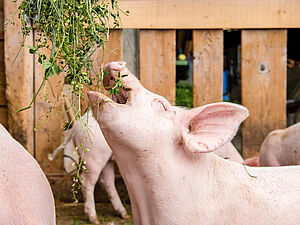Keeping animals species-appropriate is a central concern of organic farming. In addition to sufficient space and outdoor access, this also includes appropriate breeding, correct feeding and preventive measures to keep the animals healthy. Organic animal husbandry is generally less geared to achieving top performance than conventional animal husbandry, which reduces the burden on the animals and the environment.
Using interdisciplinary and participatory approaches, FiBL develops concepts to improve livestock husbandry on organic farms. The focus is on optimising husbandry conditions and management to increase animal welfare. In organic farming, breeds and genotypes which are adapted to the special conditions of organic production are used and kept under conditions that assure the highest possible animal welfare. Feeding and health care adapted to the respective genetics and performance are just as important as the equipment in the stables and design of the outdoor runs.
From 2014 until 2021, FiBL has been coordinating and supervising the Animal Welfare Competence Centre together with the Landesbetrieb Landwirtschaft Hessen (LLH). Currently FiBL is involved in the Germany-wide Netzwerk Fokus Tierwohl with the methodical didactically preparation of knowledge transfer related to animal welfare and the coordination of farmer’s networks. In other projects, that are funded within the Modell- und Demonstrationsvorhaben (MuD) Tierschutz , new findings that promote animal welfare are implemented through concrete measures. These include, for example prophylactic measures to reduce antibiotic use in poultry production or the renunciation of non-curative interventions (e.g. docking of body parts) in sheep (Welfare Competence Centre Sheep). Every year, FiBL organises up to 20 events on topics related to animal welfare and animal health.
Furthermore, optimisation approaches for the feeding of organic animals are being conceptualized. This includes for example the development of feeding strategies for organic turkeys at varying growth intensity.




